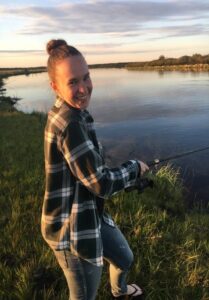
By: Jessica Froelich, 2nd Year Medical Student
This summer, myself and some colleagues made the long drive north to Dillon, Sask. as part of the College of Medicine’s Making the Links. The program prepares students for work in underserved communities and involves course-based learning, volunteering at an inner-city health clinic, and practicums in rural Indigenous communities and abroad.
Dillon is situated on Treaty 10 and the reserve territory of Buffalo River Dene Nation. Every Wednesday one or two doctors from Île-à-la-Crosse fly in to Dillon to provide patient care. They allowed us to shadow them in clinic so we could learn some of the delights and challenges of being a rural generalist.
After successfully completing my Year 1 OSCE, it was exciting to practice some new skills in a clinical setting. I was grateful for every chance to look in a new patient’s throat or listen to their heart beat. The doctors do their best to ensure people can get much of the care they need in Dillon or surrounding areas, by adapting to the needs of the community and focusing their skills on what is needed most. However, many residents must journey more than 5 hours to Saskatoon to receive the care or procedures they need. Though my learning time in the clinic was a good refresher in the knowledge I had been immersed in throughout the past year, it was the community endeavours that really helped me begin to understand what health and healing looked like in a community such as Dillon. Here, a lot of healing happens outside the white walls of the health clinic.
As student visitors, we were warmly embraced by many community members: our host family Martha, Warren, and their two teenage daughters, James a community elder, and the staff and nurses at the Buffalo River Health Centre. I presented on various health topics to the school children and hosted community events for them to attend. I went duck egg hunting, quadding along the river, participated in Treaty Days, met with Chief and Council, played bingo, fished, cut up a moose, and attended some sweats. I ate all of the bannock, fried fish, and moose stew that my belly could hold. Martha even taught me how to make her special bannock recipe.
Thus far, many of my greatest learning experiences in medicine have not been in the classroom or the clinic, but from participating in community. Early morning coffee with Martha and late-night bonfires with James led to discussions about what health and healing meant to them. “Our community doesn’t have time to heal before there is another tragedy. We can’t start healing because there is always something else that happens too soon after,” Martha once told me. Dillon is a community that has faced a lot of colonial trauma and ignoring that would not do justice to the growth and resilience of these people. “Every house here has a story like that,” she said. The resiliency and love within this community is the basis for healing from historical and ongoing trauma which has drastically impacted the health of these residents.
My time in Dillon had me reflecting on social accountability in medicine more than any lecture or course-based material ever had. I had begun to develop meaningful relationships and feel a sense of solidarity with this community. To practice medicine in a community such as Dillon, understanding what was important to them and where healing came from is as important as any other clinical skill. It means not only learning to understand what is most important to the patients you are seeing, but what their everyday lives encompass and what is integral to their very being. I have no doubt that the lessons I have learned here will be treasured throughout my career in medicine. I understand the importance of knowing the community one is working within and that healing and medicine come at many times and in many forms.

